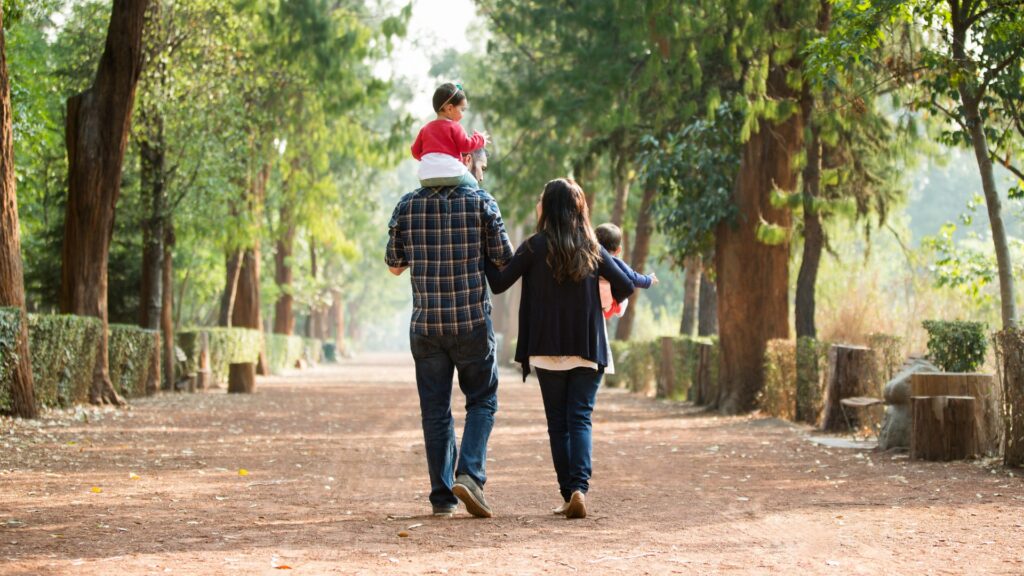Walking with the family may be easy in the beginning when everyone is happy and the activity is brand new. The following are a few tips to help you encourage your family to make walking a habit, if they are less than motivated.
1. Use triggers
Use triggers as a way to reduce the mental effort needed, and to start a walk automatically.1
Example
Have adults and children lay their walking clothes and shoes on their beds first thing in the morning to prepare for a walk that afternoon.
2. Create a walking routine
Schedule specific days and times of the week that you will walk. Remember to involve each family member in the decision-making process so that everyone feels freedom over their actions.2-5
Example
We have decided to walk as a family on Monday, Wednesday, and Friday nights from 7-7:45PM.
3. Make the purpose of the walk meaningful
As a family, discuss the importance of family and health, and then ask each person to note why walking as a family is important to them.4,6-8 Personal rewards and meaning increase the likelihood that a person will start and maintain a habit.6
Example
Some reasons why a walk could be important to a person include joy of movement, stress relief, improved mood, mental clarity, sense of accomplishment, physical health, family communication, family relationship, etc.
4. The destination and the journey
Family walks are more successful when a specific destination is selected, and a fun activity is completed when the destination is reached.9
Here are a few ideas:
- Select a specific route
- Roads, sidewalks, paths, and trails10
- Select a specific destination
- A relaxing destination increases the likelihood of walking10
- Urban areas could include a specific shop in town, a park, a specific block or neighborhood
- Rural areas could include driveway/dirt road, neighbor’s property line, favorite fishing spot, junior high/high school track
- Find a new route/destination
- Get the family involved by taking turns selecting a new walking route/destination
- Use the Out and About Activity Guides that include scavenger hunts, holiday light bingo, and fun questions to ask your family members
- Develop a hobby like bird watching
- Clean up your environment by collecting trash
- Don’t forget a trash bag and a pair of gloves for each person
- Earn rewards like a fun water bottle, pair of walking shoes, special outing, etc.
- Listen to music
- Walk the family dog
- Join Walk Across Texas
- An 8-week program designed to help individuals establish the habit of regular physical activity.
- Join the 10&10,000 Change Challenge
- A program to help you progress through 4 stages over 100 days toward a healthy lifestyle of nutrition and physical activity.
5. Make walking a family tradition
A family tradition includes customs, beliefs, values, ethics, and attitudes that are established between parents and their children and are often passed along from one generation to another.11 Traditions are a source of strength and peace that is created by bringing families together.12 Traditions allow for support, spending time together, the creation of family identity, and connection between multiple generations.12 These aspects of tradition can make family relationships stronger,14-16 and can also make a family physically stronger if creating a family tradition of walking.
A few tips on how to make walking a family tradition include:
- Involve everyone in the family to help plan and schedule time for walking
- Keep the planning simple
- Consider adding an element to the walk that is special to your family
- For example: a game, a conversation, a special destination, prayer or other religious activity, etc.
- Be consistent with when the family walks
- For example: after dinner, after homework, specific time of day, etc.
- Continue to walk over the years
For more information, view consider reading the following SYNC articles:
- The Importance of Walking as a Family
- How to Start Walking As A Family
- Overcoming Barriers to Walking with Your Family
- 7 Tips for Making Exercise A Habit
- 25 Fun Walk Ideas
References
- Kaushal, N., Rhodes, R. E., Spence, J. C., & Meldrum, J. T. (2017). Increasing physical activity through principles of habit formation in new gym members: a randomized controlled trial. Annals of Behavioral Medicine, 51(4), 578-586.
- Gardner, B., Lally, P., & Wardle, J. (2012). Making health habitual: the psychology of ‘habit-formation’and general practice. The British Journal of General Practice, 62(605), 664.
- Lally, P., Van Jaarsveld, C. H., Potts, H. W., & Wardle, J. (2010). How are habits formed: Modelling habit formation in the real world. European journal of social psychology, 40(6), 998-1009.
- Judah, G., Gardner, B., Kenward, M. G., DeStavola, B., & Aunger, R. (2018). Exploratory study of the impact of perceived reward on habit formation. BMC psychology, 6(1), 62.
- Schumacher, L. M., Thomas, J. G., Raynor, H. A., Rhodes, R. E., O’Leary, K. C., Wing, R. R., & Bond, D. S. (2019). Relationship of consistency in timing of exercise performance and exercise levels among successful weight loss maintainers. Obesity, 27(8), 1285-1291.
- Phillips, L. A., Chamberland, P. É., Hekler, E. B., Abrams, J., & Eisenberg, M. H. (2016). Intrinsic rewards predict exercise via behavioral intentions for initiators but via habit strength for maintainers. Sport, Exercise, and Performance Psychology, 5(4), 352.
- Thøgersen-Ntoumani, C., Shepherd, S. O., Ntoumanis, N., Wagenmakers, A. J., & Shaw, C. S. (2016). Intrinsic motivation in two exercise interventions: Associations with fitness and body composition. Health Psychology, 35(2), 195.
- Hopkins, N., Benstead, J., Wardle, M., & Divine, A. (2022). Associations between motivation, attitudes, and habit strength in physical activity behaviour. Journal of Physical Activity Research, 7(2), 74-80
- Milton, K., Kelly, P., Bull, F., & Foster, C. (2011). A formative evaluation of a family-based walking intervention-Furness Families Walk4Life. BMC Public Health, 11(1), 614.
- Whitfield, G. P., Carlson, S. A., Ussery, E. N., Watson, K. B., Berrigan, D., & Fulton, J. E. (2019). National-level environmental perceptions and walking among urban and rural residents: Informing surveillance of walkability. Preventive medicine, 123, 101-108.
- Schneiderman, G., & Barrera, M. (2009). Family traditions and generations. Family & Community Health, 32(4), 354-357.
- Newell, L. D. (1999). Traditions: A Foundation for Strong Families. Marriage and Families, 1(1), 2.
- Lewis, P. B., Ruby, D., & Bush-Joseph, C. A. (2012). Muscle soreness and delayed-onset muscle soreness. Clinics in sports medicine, 31(2), 255-262.
- Otto, H. A. (1962). What is a strong family?. Marriage and family Living, 24(1), 77-80.
- Stinnett, N., & DeFrain, J. D. (1985). Secrets of strong families. (No Title).
- Curran, D. (1983). Traits of a healthy family: Fifteen traits commonly found in healthy families by those who work with them. Harper San Francisco.


